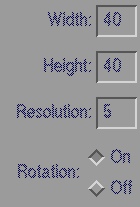 Tracker Parameters
Tracker Parameters Tracker Parameters
Tracker Parameters
 The first three parameters are very simple:
The first three parameters are very simple:
Height: How tall the tracker should be. Remember that the tracker is a rectangle. The coments above apply to this paramenter also.
This  is a 40 by 40 window,
whereas this
is a 40 by 40 window,
whereas this  is a
50 by 70 window.
is a
50 by 70 window.
Rotation: This switch determines wheather or not the tracker (rectangle) should rotate if the object it is following rotates (try it out with the switch off first and then with the switch on).
Resolution: This parameter requires a more detailed explanation. The tracker knows where the object that it is tracking goes, by examining the differences between frames in the image sequence.
If the size of the tracker is 40 x 40, then the area of the tracker is 160 pixels. That means in looking for the difference between two frames in the image sequence, the tracker will examine 160 pixels (certain features are extracted from the 40 x 40 area).
The resolution parameter divides the width/height of the tracker by a certain factor. If the tracker measures 40 x 40 and the resolution is 1, VVL will examine all 160 pixels.
If the resolution is 4, the tracker "size" will be reduced by a factor of 4, so the actual values will become 10 x 10.
The size of the tracker that appears on the screen remains the same, regardless
of the resolution value. What happens is that the sub-image under the tracker
 is reduced before it is processed internally.
is reduced before it is processed internally.
This is done by averaging groups of pixels.
Resolution's Example: Let's consider the following values for an image:
10 20 30 40 becomes 15 35. The same applies to the other rows so that the original tracker will hold the following image obtained from the original:
What impact does the resolution have on the tracking?
As mentioned above, the resolution causes values in the rectangle to be averaged. This means the image examined will contain less information (the lower the resolution value, the more information the rectangle will hold).
As a result of this, if we have a very low resolution value (such as 1), we will have more information but the tracker will be more sensitive (if the object moves too fast, it may not do a good job following it-the rectangle might be "jumpy" or completely loose the object). It will be more sensitive but also more precise-if it is able to keep up with the moving object, it's location will be more precise. A lower resolution value also means the tracking will be slower, since more computation is done.
If the resolution value is set too high, too much information will be lost due to averaging and the tracker will not do a good job. Speed will increase with a higher resolution value but at the same time precision will decrease.
It is best to find a balance in the resolution value, but you are encouraged to try out different values and try to determine what the best value is depending on the size of the tracker.
It is also important to point out that the image of the object being tracked also has an effect on the tracking (contrast, grayscale values, patterns, etc).
 Up to Tracking Contents
Up to Tracking Contents
 Back to Introduction
Back to Introduction